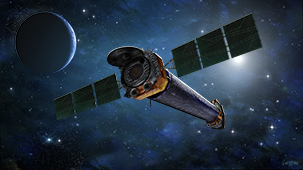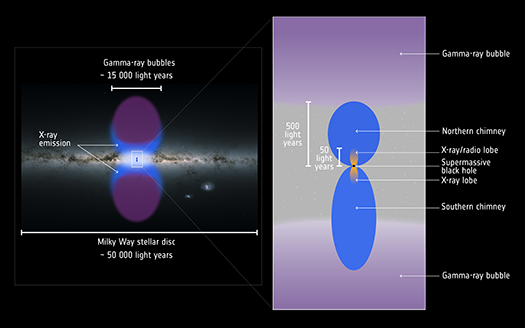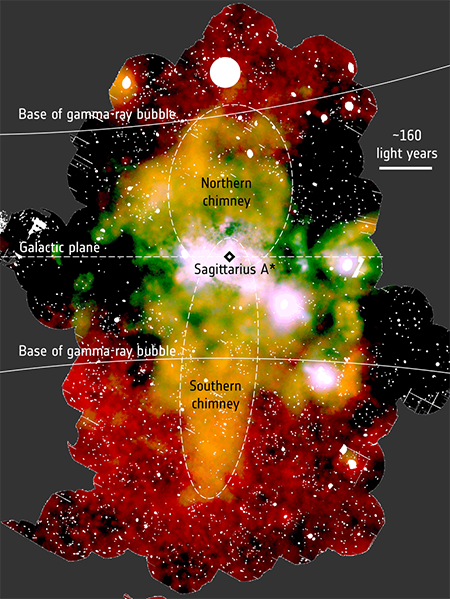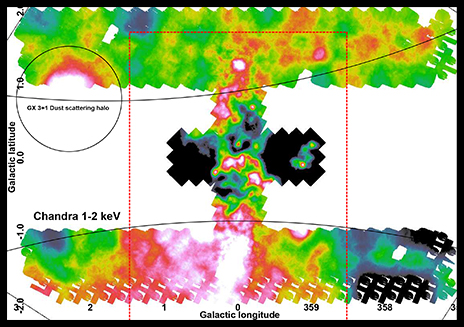Giant X-ray Chimneys and Selection Effects

Astronomers frequently talk about selection effects, where results can be biased because of the way that the objects in a sample are selected. For example, if distant galaxies above a certain X-ray flux – the amount of observed X-rays – are selected for a survey, the most distant objects will tend to be the most luminous, in other words producing the most X-rays.
For doing Chandra publicity we also have a bias, as we are always on the lookout for results where NASA’s Chandra X-ray Observatory data play a starring role. However, there are many papers where Chandra has an important supporting role instead, and other observatories are the stars. Our colleagues at the European Space Agency (ESA) and the University of California, Los Angeles (UCLA), have put out press releases on just such a result.
A team led by Gabriele Ponti of the Max Planck Institute for Extraterrestrial Physics in Garching, Germany, are reporting that they have used ESA’s XMM-Newton observatory to discover “two colossal ‘chimneys’ funneling material from the vicinity of the Milky Way’s supermassive black hole into two huge cosmic bubbles.” With the detection of these X-ray chimneys – published in Nature – astronomers can connect, for the first time, the giant bubbles detected by NASA’s Fermi gamma ray telescope with regions much closer to the black hole that have previously shown evidence for outflows of matter. In 2003, we publicized one of these results from Chandra work, led by Mark Morris of UCLA. These outflows might be driven by material falling into the supermassive black hole, or by the explosions of massive stars nearby.
Copyright: ESA/XMM-Newton/G. Ponti et al. 2019; ESA/Gaia/DPAC (Milky Way map); CC BY-SA 3.0 IGO
A large mosaic of XMM-Newton images clearly shows the chimneys, but a smaller mosaic of Chandra images also provides strong evidence for these large structures. The Chandra data also allowed Ponti and his team to make cross-checks with their XMM-Newton data in other ways. They were able to show with both XMM-Newton and Chandra that the upper and lower chimneys have similar properties, such as the densities and temperatures of the hot gas. This implies that both chimneys have the same origin. Cross-checks like these are how solid science is done.
XMM-Newton image. Credit: ESA/XMM-Newton/G. Ponti et al.
Chandra image Credit: NASA/CXC/G. Ponti et al.
Results from multiple observatories are often used in papers, at varying levels, but it’s challenging to get all of them covered in publicity, and the same applies to the scientists involved in the study. In our public affairs roles we need to promote our institution and observatories and scientists, but we also want to succinctly describe the science, which is what a general audience cares about the most. The story here about huge chimneys venting X-rays from the center of the galaxy is easier to tell without trying to give quotes to all nine authors. Other papers can have much longer lists of authors, including LIGO papers, which have more than a thousand. Even for single-author papers, other astronomers will have played a role in refereeing the paper, and giving advice, and making important advances in previous work. All of this means that press releases and media reports can give an exciting but biased view about how science is done, with just a few researchers described using just one or two observatories. It’s important to remember that astronomy research is fundamentally a team effort.
Peter Edmonds, CXC
Category:
- Log in to post comments



